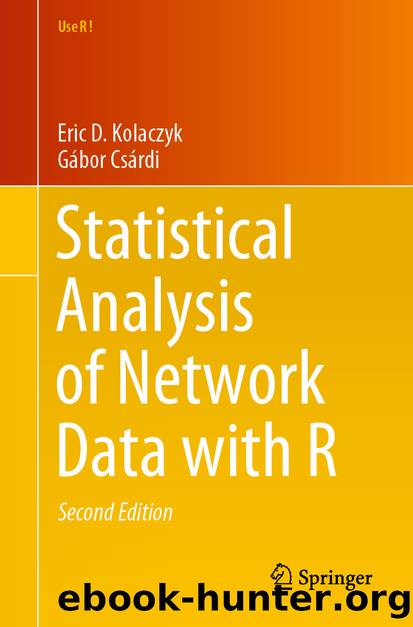Statistical Analysis of Network Data with R by Eric D. Kolaczyk & Gábor Csárdi

Author:Eric D. Kolaczyk & Gábor Csárdi
Language: eng
Format: epub
ISBN: 9783030441296
Publisher: Springer International Publishing
6.4.3 Model Fitting
By construction, the latent network model has a hierarchical specification, so a Bayesian approach to inference is natural here. The package eigenmodel implements the eigenmodel formulation described above and will be the one with which we illustrate here.17
The function eigenmodel_mcmc in eigenmodel uses Monte Carlo Markov Chain (MCMC) techniques to simulate from the relevant posterior distributions, using largely conjugate priors to complete the model specification. Of potential interest are the parameter (describing the effects of pair-specific covariates ), the elements of the diagonal matrix (summarizing the relative importance of each latent vector ), and the latent vectors themselves. Since the inferred latent vectors are not orthogonal, it is useful in interpreting model output to use in their place the eigenvectors of the matrix .
The network lazega of collaborations among lawyers allows for demonstration of a number of the concepts we have discussed so far. Recall that this network involved 36 lawyers, at three different office locations, involved in two types of practice (i.e., corporate and litigation).
We might hypothesize that collaboration in this setting is driven, at least in part, by similarity of practice, a form of homophily. On the other hand, we could similarly hypothesize that collaboration is instead driven by shared office location, which could be interpreted as a proxy for distance. Because the eigenmodel formulation of latent network models is able to capture aspects of both distance and homophily, it is interesting to compare the fitted models that we obtain for three different eigenmodels, specifying (i) no pair-specific covariates, (ii) a covariate for common practice, and (iii) a covariate for shared office location, respectively.
To fit the model with no pair-specific covariates and a latent eigen-space of dimensions is accomplished as follows.18
In order to include the effects of common practice, we create an array with that information
and fit the model with this additional argument
Finally, we do similarly for the model that includes information on shared office locations.
In order to compare the representation of the network lazega in each of the underlying two-dimensional latent spaces inferred for these models, we extract the eigenvectors for each fitted model
and plot the network in igraph using these coordinates as the layout.19 For example,
generates the visualization corresponding to the fit without any pair-specific covariates, and those for the other two models are obtained similarly (Fig. 6.4).
Fig. 6.4Visualizations of the network of Lazega’s lawyers, with layouts determined according to the inferred latent eigenvectors in models with no pair-specific covariates (left), a covariate for common practice (center), and a covariate for shared office location (right)
Download
This site does not store any files on its server. We only index and link to content provided by other sites. Please contact the content providers to delete copyright contents if any and email us, we'll remove relevant links or contents immediately.
Grails in Action by Glen Smith Peter Ledbrook(8034)
Sass and Compass in Action by Wynn Netherland Nathan Weizenbaum Chris Eppstein Brandon Mathis(8033)
Configuring Windows Server Hybrid Advanced Services Exam Ref AZ-801 by Chris Gill(7410)
Azure Containers Explained by Wesley Haakman & Richard Hooper(7408)
Running Windows Containers on AWS by Marcio Morales(6946)
Kotlin in Action by Dmitry Jemerov(5504)
Microsoft 365 Identity and Services Exam Guide MS-100 by Aaron Guilmette(5380)
Microsoft Cybersecurity Architect Exam Ref SC-100 by Dwayne Natwick(5184)
Combating Crime on the Dark Web by Nearchos Nearchou(4959)
The Ruby Workshop by Akshat Paul Peter Philips Dániel Szabó and Cheyne Wallace(4648)
Management Strategies for the Cloud Revolution: How Cloud Computing Is Transforming Business and Why You Can't Afford to Be Left Behind by Charles Babcock(4519)
Python for Security and Networking - Third Edition by José Manuel Ortega(4216)
The Age of Surveillance Capitalism by Shoshana Zuboff(4205)
Learn Wireshark by Lisa Bock(4086)
The Ultimate Docker Container Book by Schenker Gabriel N.;(3871)
Learn Windows PowerShell in a Month of Lunches by Don Jones(3600)
DevSecOps in Practice with VMware Tanzu by Parth Pandit & Robert Hardt(3548)
Windows Ransomware Detection and Protection by Marius Sandbu(3530)
Blockchain Basics by Daniel Drescher(3493)
